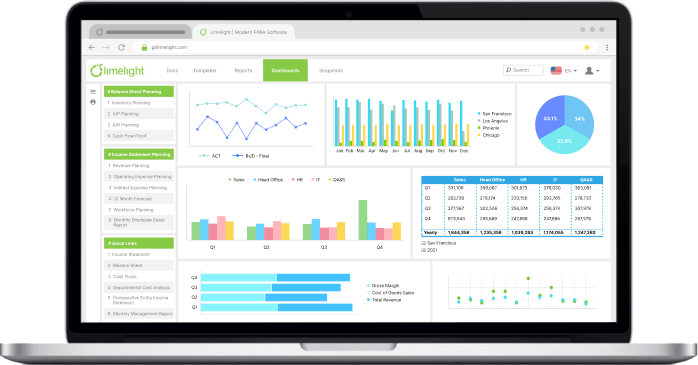CPM
How to Determine the Right CPM Software Solutions for Your Business

By Jade Cole |
Published: January 29, 2019

By Jade Cole |
Published: January 29, 2019
Whether public, private, small or large, all organizations need to plan. They need to plan for existing operations, they need to plan for growth and even plan for unexpected or extraordinary events. That's where Corporate Performance Management software comes in. In the current Corporate Performance Management CPM software solutions market (also known as enterprise performance management EPM), there are a lot of choices available to prospective buyers.
The first consideration when implementing any software in an organization is to determine what goal you are trying to achieve. Some examples of goals for organizations looking to improve existing processes include:
• Reducing the amount of low-value, manual work being done
• Provide more data and analysis
• Allow changes to be made quickly
• Reduce errors
Reducing Low-Value, Manual Work
Being competitive means being able to do more with less – in a manual, Excel based planning and reporting process, a lot of time is spent collecting, aggregating and checking spreadsheets.
Provide More Data and Analysis
When processes are manual, the inevitable focus is on getting the bare minimum of what is needed.
Allow Changes to Be Made Quickly
Being able to model changes like top-down adjustments, price or exchange rate fluctuations and do comparative scenarios enables more robust planning without increasing manual work.
Reduce Errors
Copy & paste errors, formula errors in spreadsheets, entry of invalid data (misspelled business units, incorrect accounts) all create more headaches for the planning team and provide little business value.
An evaluation of CPM vendors should narrow your choices down to which ones meet your business objectives, at a cost that is business justified. There are also technical considerations to be made.
To make your evaluation easier, check out our curated list of the Top CPM Software in 2025 - a detailed comparison of leading Corporate Performance Management tools to help you choose the right fit for your organization.
Cloud or On-Premise?
Does your organization prefer an on-premise or cloud-based solution? Cloud is a major shift for many businesses – some are ahead of the curve, some are more reluctant to move into what they perceive is a new, riskier technology even while acknowledging the benefits. If you prefer an on-premise solution, then cloud-only CPM solutions are obviously not a fit.
Browser-Based or Client Install?
Since the early 2000's, software vendors have been increasingly moving to browser-based interfaces for their products. The advent of cloud as a robust deployment platform – along with mobile technology – has accelerated the move away from traditional desktop-based solutions such as Excel add-ins or Windows installed desktop applications.
There are several benefits to browser-based technology, namely:
• Zero-footprint deployment
• Easy updates for all users, regardless of their physical location
• Access on any platform that runs a supported browser
• Mobile device support
• More portable – all users need is a web link
Some vendors have architected their solution around Excel – building add-ins that attempt to use Excel as the interface while connecting to their databases.
There are several issues with this approach:
• Users still need Excel licenses, and there are probably restrictions on which version of Excel (i.e. Windows vs. Mac) can be used
• The add-in needs to be installed on the user’s machine. For organizations that allow users to bring their own device, this needs to be managed
• Updates to Office (which Microsoft is doing constantly) must be considered
Improvements in browser technology and standards such as HTML 5 have allowed browser-based apps to provide the same rich, interactive experience that used to be only available on desktop apps. These advances allow organizations to provide their users with powerful, intuitive tools without the pain of installing and managing client software in a heterogeneous device world.
Key Considerations
Regardless of the CPM vendors you are evaluating, here are the key considerations you should incorporate into your decision-making process:
• Integration with source systems
• Ease of use
• Cost of Implementation & TCO
Integration with Source Systems
With many enterprise systems now moving to the cloud, it’s important to consider where your data is, and how your CPM tool will leverage it. Do the CPM tools you’re considering integrate with your cloud ERP, Payroll, CRM or other operational systems? Is that integration part of the standard offering, or is it an additional cost that creeps in later?
Ease of Use
It’s important to ensure that whatever tool you choose, your users will actually use it. The last thing you want after going through a CPM deployment is for users to retreat back into Excel. One of the biggest mistakes we’ve seen businesses make is choosing a product because it’s from a preferred vendor, or because it was the same product that the decision makers used in the past, rather than if it truly provides their users with the experience they want, which will ensure adoption and provide ROI.
Cost of Implementation & Total Cost of Ownership (TCO)
Assuming a tool fits your needs, how easy is it to implement? Does it require deep technical knowledge or specialized consulting skills to make simple changes? How will you build new reports? Once the system is deployed, does the vendor continue to support you? What if new people join the company and need to be added to the system? Ease of implementation directly impacts the cost of deploying the system and the long-term cost of upkeep and enhancements.
What is it like to actually implement and use a CPM tool? Watch our webinar on how a CPM works with your ERP and data sources to deliver the strategic insights your business needs.
And get in touch with us and discover how Limelight FP&A software can make your budgeting, planning, and forecasting activities faster and more accurate. With Limelight, you'll be able to better:
Limelight relieves your team of repetitive data chasing and mind-numbing Excel inputs so they can use their time and expertise to help your organization plan and grow. Get access to your financial data, financial performances, business performance data, management reporting, financial statements and more in a consolidated and automated platform that accelerates and enhances your FP&A efforts.
Subscribe to our newsletter


